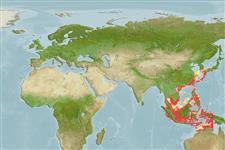Common names from other countries
Environment: milieu / climate zone / depth range / distribution range
Ekologi
Berasosiasi dengan karang; payau; kisaran kedalaman 0 - 65 m (Ref. 111223). Tropical, preferred 26°C (Ref. 107945); 35°N - 15°S, 99°E - 137°E
Indo-West Pacific: from China, Japan and Korea to Philippines and westwards to the straits of Malaccca, also present in the Northern Territory, Australia. Tropical to subtropical.
Length at first maturity / Size / Weight / umur
Maturity: Lm 6.5, range 6 - ? cm Max length : 20.0 cm CW jantan/; (Ref. 343)
Carapace rough to granulose, regions discernible; front with 4 acutely triangular teeth; 9 teeth on each anterolateral margin, the last tooth 2 to 4 times larger than preceding teeth. Chelae elongate in males; larger chela with conical tooth at base of fingers; pollex ridged. Color: males with blue markings, females dull green.
Matures at about 1 year. Collected mainly by artisanal traps, trawls, beach seines, cylindrical wire traps, folding traps, pots, hop nets, drop nets, and sunken crab gill nets. In shallow waters, it is caught using beach seines, rakes, and dab nets. Sold in local markets (fresh or frozen) and for the crab-flesh canning industry. Most widely sold in markets of Southeast Asia, including the Philippines (Ref. 343). Maximum depth from Ref. 801.
Members of the order Decapoda are mostly gonochoric. Mating behavior: Precopulatory courtship ritual is common (through olfactory and tactile cues); usually indirect sperm transfer.
rujukan utama
Acuan | Koordinator | mitra
Ng, P.K.L. 1998. (Ref. 343)
Status IUCN Red List (Ref. 130435: Version 2024-1)
status CITES (Ref. 108899)
Not Evaluated
Not Evaluated
ancaman kepada manusia
Poisonous to eat (Ref. 130554)
penggunaan manusia
Perikanan: bernilai komersial tinggi
FAO - Budidaya air: production; Perikanan: landings, profail spesis | FishSource | Sea Around Us
Alat, peralatan
Sumber internet
Estimates based on models
Preferred temperature
(Ref.
115969): 18.1 - 29, mean 27.6 (based on 1324 cells).
Daya lenting
Tinggi, Waktu penggandaan populasi minimum kurang dari 15 bulan (K=0.1-3.11).
Prior r = 1.19, 95% CL = 0.78 - 1.78, Based on 22 data-limited stock assessments.
keancaman
Low vulnerability (10 of 100).
